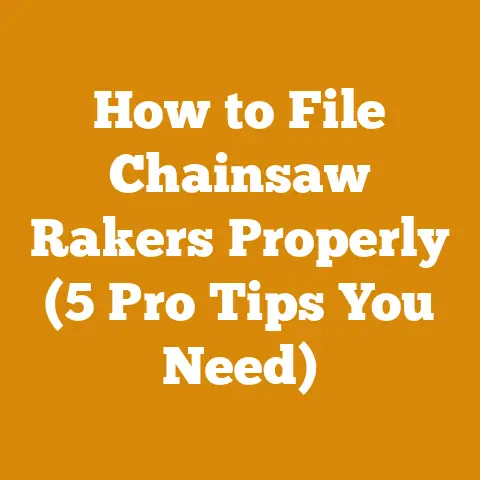Stihl 028 Parts Diagram Guide (Vintage Model Repair Tips)
Did you ever wonder how many forgotten Stihl 028 chainsaws are still humming away in sheds and garages, faithfully cutting wood year after year? It’s a testament to their robust design and enduring quality. But even the best machines eventually need a little TLC. That’s where understanding your saw and having access to a detailed parts diagram becomes crucial. In this guide, I’ll delve into the intricacies of the Stihl 028, focusing on its parts diagram and providing vintage model repair tips. I’ll share my experiences, insights, and advice to help you keep your trusty saw running for years to come.
The Enduring Legacy of the Stihl 028
The Stihl 028 is more than just a chainsaw; it’s a piece of logging history. Introduced in the late 1970s, it quickly gained a reputation for reliability and power. I remember my grandfather using one for years, felling trees and bucking firewood with unwavering confidence. These saws were built to last, a far cry from some of the more disposable models we see today. The 028 came in several variations, including the 028, 028 Super, and 028 Wood Boss, each with slight differences in specifications and features.
Why Understanding the Parts Diagram is Essential
A parts diagram is your roadmap to understanding the inner workings of your Stihl 028. It’s a detailed visual representation of every component, from the smallest screw to the largest cylinder. Having access to this diagram allows you to:
- Identify Parts Accurately: When ordering replacements, you need to be sure you’re getting the right part. The diagram provides the part numbers and visual references to avoid costly mistakes.
- Diagnose Problems: By studying the diagram, you can understand how different parts interact and identify potential sources of malfunctions.
- Disassemble and Reassemble Confidently: The diagram serves as a guide during disassembly, ensuring you don’t lose track of parts or struggle with reassembly.
- Perform Maintenance Effectively: Understanding the location and function of each part makes routine maintenance tasks more efficient and thorough.
Finding the Right Parts Diagram for Your Model
Before diving into repairs, you need to locate the correct parts diagram for your specific Stihl 028 variant. Here’s how:
- Check Your Saw’s Model Number: Look for a sticker or engraving on the saw’s housing. It should clearly state the model (e.g., 028, 028 Super, 028 Wood Boss).
- Consult the Stihl Website: Stihl’s official website often has archived parts diagrams for older models. You’ll need the model number and possibly the serial number to find the correct diagram.
- Search Online Parts Retailers: Many online retailers specializing in chainsaw parts offer downloadable parts diagrams. Sites like HL Supply, eBay, and Amazon often have these resources available.
- Check Chainsaw Forums: Chainsaw forums and online communities are treasure troves of information. Members often share scanned copies of parts diagrams and offer valuable advice.
- Visit a Local Stihl Dealer: Your local Stihl dealer can provide you with a printed or digital copy of the parts diagram. They can also help you identify the correct diagram based on your saw’s serial number.
Takeaway: Always verify that the parts diagram matches your specific Stihl 028 variant to avoid ordering the wrong parts or following incorrect assembly instructions.
Decoding the Stihl 028 Parts Diagram
Once you have the diagram in hand (or on your screen), it’s time to learn how to interpret it. Parts diagrams typically consist of exploded views, part numbers, and descriptions. Let’s break down each element:
Understanding Exploded Views
Exploded views are the heart of the parts diagram. They show each component of the chainsaw separated from the others, but in their relative positions. This allows you to visualize how the parts fit together.
- Grouping of Parts: Parts are often grouped by function, such as the engine components, the carburetor assembly, or the oiling system.
- Numbering System: Each part is assigned a unique number that corresponds to the part list.
- Orientation: Pay attention to the orientation of parts in the exploded view. This is crucial for proper reassembly.
Interpreting Part Numbers and Descriptions
Each part in the diagram is identified by a specific part number and a brief description. This information is essential for ordering replacement parts.
- Part Numbers: Stihl part numbers are typically a series of digits, sometimes with letters. These numbers are unique to each component.
- Descriptions: The description provides a brief explanation of the part, such as “Piston,” “Cylinder,” or “Carburetor Gasket.”
- Superseded Part Numbers: Sometimes, a part number may be superseded by a newer version. The diagram may indicate this with a note like “Replaces Part Number XXXXX.”
Common Sections in the Parts Diagram
The Stihl 028 parts diagram is typically divided into sections based on the major components of the chainsaw. Here are some of the most common sections:
- Engine: This section includes the cylinder, piston, crankshaft, connecting rod, and other engine-related parts.
- Carburetor: This section covers the carburetor body, jets, needles, diaphragms, and other carburetor components.
- Ignition System: This section includes the ignition coil, spark plug, flywheel, and related wiring.
- Fuel System: This section covers the fuel tank, fuel lines, fuel filter, and fuel cap.
- Oiling System: This section includes the oil pump, oil lines, oil filter, and oil tank.
- Chain and Bar: This section covers the chain, bar, sprocket, and chain tensioner.
- Housing and Covers: This section includes the chainsaw’s housing, covers, and handles.
Takeaway: Familiarize yourself with the different sections of the parts diagram and learn how to identify parts by their numbers and descriptions.
Essential Tools for Stihl 028 Repair
Before you start disassembling your Stihl 028, it’s essential to have the right tools on hand. Using the correct tools will not only make the job easier but also prevent damage to the saw’s components. Here’s a list of tools I recommend:
- Screwdrivers: A set of screwdrivers, including both flathead and Phillips head, is essential. Make sure you have a variety of sizes.
- Socket Set: A socket set with metric sockets is necessary for removing nuts and bolts. A 3/8″ drive socket set is usually sufficient.
- Wrenches: A set of open-end wrenches and combination wrenches is helpful for various tasks. Metric sizes are required.
- Pliers: A set of pliers, including needle-nose pliers and regular pliers, is useful for gripping and manipulating small parts.
- Spark Plug Wrench: A spark plug wrench is specifically designed for removing and installing spark plugs.
- Piston Stop Tool: A piston stop tool is used to prevent the piston from moving when removing the clutch or flywheel.
- Flywheel Puller: A flywheel puller is used to remove the flywheel from the crankshaft. This is often necessary for accessing the ignition system.
- Compression Tester: A compression tester is used to measure the compression in the cylinder. This can help diagnose engine problems.
- Multimeter: A multimeter is used to test electrical components, such as the ignition coil.
- Carburetor Adjustment Tool: A carburetor adjustment tool is used to adjust the carburetor settings.
- Cleaning Supplies: Cleaning supplies, such as carburetor cleaner, degreaser, and rags, are essential for cleaning parts during disassembly and reassembly.
- Work Gloves: Work gloves will protect your hands from dirt, grease, and sharp edges.
- Safety Glasses: Safety glasses will protect your eyes from debris.
- Parts Tray: A parts tray with compartments is helpful for organizing and storing small parts during disassembly.
- Service Manual: A service manual provides detailed instructions and diagrams for repairing the Stihl 028.
Takeaway: Invest in a good set of tools. It will save you time, frustration, and potential damage to your chainsaw.
Common Stihl 028 Problems and Solutions
Even with proper maintenance, Stihl 028 chainsaws can experience problems over time. Here are some of the most common issues I’ve encountered and their solutions:
1. Hard Starting or No Start
This is a frequent issue with older chainsaws. Here are the potential causes:
- Clogged Carburetor: Fuel varnish can build up in the carburetor, especially if the saw has been sitting for a while. Solution: Clean the carburetor thoroughly using carburetor cleaner. Disassemble the carburetor and soak the parts in cleaner. Replace any worn or damaged gaskets and diaphragms.
- Dirty Air Filter: A dirty air filter restricts airflow to the engine. Solution: Clean or replace the air filter. Use compressed air to blow out the filter or wash it with soap and water.
- Fouled Spark Plug: A fouled spark plug can prevent the engine from starting. Solution: Clean or replace the spark plug. Check the spark plug gap and adjust it if necessary. The correct gap for the Stihl 028 is typically 0.5mm (0.020 inches).
- Weak Ignition Coil: A weak ignition coil may not provide enough spark to ignite the fuel mixture. Solution: Test the ignition coil with a multimeter. If it’s weak, replace it.
- Fuel Problems: Old or contaminated fuel can cause starting problems. Solution: Drain the fuel tank and replace the fuel with fresh, high-octane gasoline mixed with the correct amount of two-stroke oil. The recommended fuel-to-oil ratio for the Stihl 028 is typically 50:1.
- Low Compression: Low compression can prevent the engine from starting. Solution: Test the compression with a compression tester. If the compression is low, the engine may need to be rebuilt. A healthy Stihl 028 should have a compression reading of at least 120 PSI.
2. Chain Not Oiling
Proper chain lubrication is crucial for the life of the chain and bar. Here are the potential causes of chain oiling problems:
- Clogged Oil Filter: A clogged oil filter can restrict oil flow to the chain. Solution: Clean or replace the oil filter.
- Blocked Oil Line: A blocked oil line can prevent oil from reaching the bar. Solution: Disconnect the oil line and blow it out with compressed air.
- Faulty Oil Pump: A faulty oil pump may not be pumping enough oil. Solution: Inspect the oil pump for wear or damage. Replace the oil pump if necessary.
- Incorrect Oil: Using the wrong type of oil can cause oiling problems. Solution: Use a high-quality bar and chain oil specifically designed for chainsaws.
- Vent Issues: The oil tank vent can become plugged with debris. This creates a vacuum, preventing oil from flowing. Solution: Clean the vent. It’s usually a small hole in the oil tank cap.
3. Chain Brakes Malfunctioning
A properly functioning chain brake is essential for safety. Here are the potential causes of chain brake problems:
- Worn Brake Band: The brake band can wear out over time. Solution: Inspect the brake band for wear. Replace the brake band if necessary.
- Contaminated Brake Mechanism: Dirt and debris can contaminate the brake mechanism. Solution: Clean the brake mechanism with a brush and compressed air.
- Broken Spring: A broken spring can prevent the brake from engaging properly. Solution: Inspect the springs in the brake mechanism. Replace any broken springs.
- Improper Adjustment: The chain brake may need to be adjusted. Solution: Consult the service manual for instructions on adjusting the chain brake.
4. Excessive Vibration
Excessive vibration can be a sign of a serious problem. Here are the potential causes:
- Loose Mounts: Loose engine or handle mounts can cause vibration. Solution: Tighten all engine and handle mounts.
- Worn Anti-Vibration Mounts: The anti-vibration mounts can wear out over time. Solution: Inspect the anti-vibration mounts for wear or damage. Replace the anti-vibration mounts if necessary.
- Damaged Crankshaft Bearings: Damaged crankshaft bearings can cause excessive vibration. Solution: Inspect the crankshaft bearings. If they are damaged, the engine may need to be rebuilt.
- Bent Bar: A bent chainsaw bar will cause vibration. Solution: Replace the bar.
5. Engine Overheating
Overheating can damage the engine. Here are the potential causes:
- Dirty Cooling Fins: Dirty cooling fins can restrict airflow to the engine. Solution: Clean the cooling fins with a brush and compressed air.
- Incorrect Fuel Mixture: An incorrect fuel mixture can cause the engine to overheat. Solution: Use the correct fuel-to-oil ratio.
- Clogged Exhaust Port: A clogged exhaust port can restrict exhaust flow and cause the engine to overheat. Solution: Clean the exhaust port.
- Lean Carburetor Setting: A lean carburetor setting can cause the engine to overheat. Solution: Adjust the carburetor settings.
Takeaway: Regular maintenance and prompt attention to problems can prevent major repairs and extend the life of your Stihl 028.
Vintage Model Repair Tips
Repairing a vintage Stihl 028 requires a slightly different approach than working on newer models. Here are some tips I’ve learned over the years:
Sourcing Parts
Finding replacement parts for a vintage chainsaw can be challenging. Here are some strategies:
- Online Retailers: Online retailers specializing in chainsaw parts are a good place to start. Sites like HL Supply, eBay, and Amazon often have parts for older models.
- Stihl Dealers: Your local Stihl dealer may still have some parts in stock or be able to order them.
- Chainsaw Forums: Chainsaw forums and online communities are a great resource for finding parts. Members often have spare parts for sale or can point you in the right direction.
- Salvage Yards: Salvage yards that specialize in small engines may have Stihl 028s that can be used for parts.
- NOS (New Old Stock) Parts: NOS parts are new, unused parts that are no longer in production. These parts can be found online or at specialized retailers.
Dealing with Corrosion and Rust
Older chainsaws are often affected by corrosion and rust. Here’s how to deal with it:
- Cleaning: Use a wire brush, sandpaper, or a rust remover to clean corroded or rusty parts.
- Lubrication: Apply a lubricant, such as WD-40 or penetrating oil, to loosen rusted bolts and nuts.
- Replacement: If a part is severely corroded or rusted, it may need to be replaced.
Working with Old Rubber and Plastic
Rubber and plastic parts can become brittle and cracked over time. Here’s how to handle them:
- Careful Handling: Handle old rubber and plastic parts with care to avoid breaking them.
- Replacement: If a rubber or plastic part is cracked or damaged, it should be replaced.
- Conditioning: Rubber parts can be conditioned with a rubber protectant to help prevent them from drying out and cracking.
Rebuilding the Carburetor
The carburetor is often the source of problems in older chainsaws. Here’s how to rebuild it:
- Disassembly: Disassemble the carburetor carefully, noting the location of each part.
- Cleaning: Clean all of the carburetor parts thoroughly with carburetor cleaner.
- Inspection: Inspect the carburetor parts for wear or damage. Replace any worn or damaged parts.
- Reassembly: Reassemble the carburetor, following the instructions in the service manual.
- Adjustment: Adjust the carburetor settings after reassembly.
Ignition System Troubleshooting
The ignition system can be a source of problems in older chainsaws. Here’s how to troubleshoot it:
- Spark Plug Test: Test the spark plug to see if it is producing a spark.
- Ignition Coil Test: Test the ignition coil with a multimeter to see if it is producing enough voltage.
- Wiring Inspection: Inspect the wiring for damage or corrosion.
- Flywheel Inspection: Inspect the flywheel for damage or misalignment.
Takeaway: Patience and careful attention to detail are essential when repairing a vintage Stihl 028.
Safety First: A Word on Chainsaw Safety
No guide to chainsaw repair would be complete without a strong emphasis on safety. Chainsaws are powerful tools that can cause serious injury if not used properly. Here are some essential safety precautions:
- Wear Appropriate Safety Gear: Always wear safety glasses, hearing protection, work gloves, and chainsaw chaps when operating a chainsaw.
- Read the Owner’s Manual: Familiarize yourself with the chainsaw’s operating instructions and safety features.
- Inspect the Chainsaw: Before each use, inspect the chainsaw for any damage or loose parts.
- Maintain a Safe Distance: Keep a safe distance from other people and obstacles when operating a chainsaw.
- Use Proper Cutting Techniques: Use proper cutting techniques to avoid kickback.
- Never Cut Above Shoulder Height: Cutting above shoulder height is dangerous and can lead to loss of control.
- Be Aware of Your Surroundings: Be aware of your surroundings and watch out for hazards such as branches, rocks, and uneven terrain.
- Never Operate a Chainsaw When Tired or Under the Influence: Operating a chainsaw when tired or under the influence of drugs or alcohol is extremely dangerous.
- Store the Chainsaw Safely: Store the chainsaw in a safe place where it cannot be accessed by children or unauthorized users.
- Sharpen the Chain Regularly: A sharp chain is safer and more efficient than a dull chain.
Understanding Kickback
Kickback is one of the most common causes of chainsaw injuries. It occurs when the upper tip of the chainsaw bar contacts a solid object or is pinched. This can cause the chainsaw to suddenly kick back towards the operator.
- Avoid Cutting with the Upper Tip: Avoid cutting with the upper tip of the chainsaw bar.
- Use a Reduced-Kickback Chain: Use a reduced-kickback chain to help prevent kickback.
- Maintain a Firm Grip: Maintain a firm grip on the chainsaw with both hands.
- Stand to the Side: Stand to the side of the cutting path to avoid being struck by the chainsaw if kickback occurs.
Takeaway: Safety should always be your top priority when working with chainsaws.
Maintaining Your Stihl 028 for Longevity
Proper maintenance is key to extending the life of your Stihl 028. Here are some essential maintenance tasks:
Regular Cleaning
- Air Filter: Clean the air filter after each use.
- Cooling Fins: Clean the cooling fins regularly to prevent overheating.
- Chain and Bar: Clean the chain and bar after each use.
- Sawdust Removal: Remove sawdust and debris from the chainsaw housing.
Lubrication
- Chain and Bar: Lubricate the chain and bar with high-quality bar and chain oil.
- Moving Parts: Lubricate moving parts, such as the chain tensioner, with a light oil.
Sharpening the Chain
- Regular Sharpening: Sharpen the chain regularly to maintain its cutting efficiency.
- Proper Tools: Use the correct tools for sharpening the chain.
- Consistent Angle: Maintain a consistent angle when sharpening the chain.
Checking and Replacing Parts
- Spark Plug: Check the spark plug regularly and replace it if necessary.
- Fuel Filter: Check the fuel filter regularly and replace it if necessary.
- Oil Filter: Check the oil filter regularly and replace it if necessary.
- Fuel Lines: Inspect the fuel lines for cracks or leaks and replace them if necessary.
Proper Storage
- Empty the Fuel Tank: Empty the fuel tank before storing the chainsaw for an extended period.
- Clean the Chainsaw: Clean the chainsaw thoroughly before storing it.
- Store in a Dry Place: Store the chainsaw in a dry place to prevent rust and corrosion.
Takeaway: Regular maintenance will keep your Stihl 028 running smoothly and reliably for years to come.
Conclusion: Keeping the Legacy Alive
The Stihl 028 is a testament to enduring quality and thoughtful design. By understanding its parts diagram, performing regular maintenance, and addressing problems promptly, you can keep this vintage chainsaw running for many years to come. It’s more than just a tool; it’s a piece of history. I hope this guide has provided you with the knowledge and confidence to tackle any repair and keep the legacy of the Stihl 028 alive. Now, go forth and keep those chainsaws humming!






